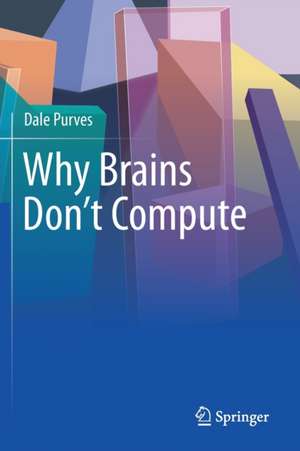Why Brains Don't Compute
Autor Dale Purvesen Limba Engleză Paperback – 8 mai 2022
The goal is to encourage neuroscientists, computer scientists, philosophers, and other interested readers to consider this concept of neural function and its implications, not least of which is the conclusion that brains don’t “compute.”
| Toate formatele și edițiile | Preț | Express |
|---|---|---|
| Paperback (1) | 522.10 lei 6-8 săpt. | |
| Springer International Publishing – 8 mai 2022 | 522.10 lei 6-8 săpt. | |
| Hardback (1) | 727.48 lei 6-8 săpt. | |
| Springer International Publishing – 8 mai 2021 | 727.48 lei 6-8 săpt. |
Preț: 522.10 lei
Preț vechi: 614.24 lei
-15% Nou
Puncte Express: 783
Preț estimativ în valută:
99.92€ • 108.49$ • 83.93£
99.92€ • 108.49$ • 83.93£
Carte tipărită la comandă
Livrare economică 23 aprilie-07 mai
Preluare comenzi: 021 569.72.76
Specificații
ISBN-13: 9783030710668
ISBN-10: 3030710661
Pagini: 168
Ilustrații: XV, 168 p. 54 illus., 45 illus. in color.
Dimensiuni: 155 x 235 x 13 mm
Greutate: 0.27 kg
Ediția:1st ed. 2021
Editura: Springer International Publishing
Colecția Springer
Locul publicării:Cham, Switzerland
ISBN-10: 3030710661
Pagini: 168
Ilustrații: XV, 168 p. 54 illus., 45 illus. in color.
Dimensiuni: 155 x 235 x 13 mm
Greutate: 0.27 kg
Ediția:1st ed. 2021
Editura: Springer International Publishing
Colecția Springer
Locul publicării:Cham, Switzerland
Cuprins
Preface.- PART I. TWO REALITIES.- Chapter 1. Solving Problems.- Chapter 2. Objective and Subjective Reality.- PART II. Computation; Chapter 3. Algorithms.- Chapter 4. Coding for Computers.- PART III. ARTIFICIAL NEURAL NETWORKS.- Chapter 5. Neural Networks.- Chapter 6. The Resurrection of Neural Networks.- Chapter 7. Reinforcement Learning.- Part IV. perception; Chapter 8. What We Perceive.- Chapter 9. Lines and Intervals.- Chapter 10. Angles.- Chapter 11. Lightness and Darkness.- Chapter 12. Empirical Ranking.- Chapter 13. Color.- Chapter 14. Colorimetry.- Chapter 15. Motion Speed.- Chapter 16. Motion Direction.- Chapter 17. Size.- Chapter 18. Stereopsis.- PART V. Linking OBJECTIVE AND SUBJECTIVE.- Chapter 19. Stimuli and Behavior.- Chapter 20. Associations.- Chapter 21. Mechanisms.- Chapter 22. Reflexes.- PART VI. THEORIES.- Chapter 23. Feature Detection.- Chapter 24. Statistical Inference.- Chapter 25. Information Theory.- PART VII. SELF AWARENESS; Chapter 26. Awareness.- Chapter 27. Summing Up.
Recenzii
“I highly recommend this volume for behavioral, cognitive, and evolutionary neuroscientists.” (Paul Tibbetts, The Quarterly Review of Biology, Vol. 97 (2), June, 2022)
Notă biografică
Dale Purves is the George B. Geller Professor of Neurobiology Emeritus in the Duke Institute for Brain Sciences where he remains Research Professor with additional appointments in the department of Psychology and Brain Sciences and the department of Philosophy at Duke University. After earning a B.A. from Yale, an M.D. from Harvard and additional postdoctoral training at Harvard and University College London, he joined the faculty at Washington University School of Medicine in 1973. In 1990 he became the founding chair of the Department of Neurobiology at Duke Medical Center and was subsequently Director of Duke's Center for Cognitive Neuroscience. He also served as the Director of the Neuroscience and Behavioral Disorders Program at the Duke-NUS Graduate Medical School in Singapore .
Best known for his work on neural development and synaptic plasticity, Purves’ research during the last 20 years has sought to explain visual perception and auditory perception in the context of music. He is a member of the National Academy of Sciences, the National Academy of Medicine, a fellow of the American Academy of Arts and Sciences and is the author, and co-author or editor of 18 previous books on neuroscience.
Best known for his work on neural development and synaptic plasticity, Purves’ research during the last 20 years has sought to explain visual perception and auditory perception in the context of music. He is a member of the National Academy of Sciences, the National Academy of Medicine, a fellow of the American Academy of Arts and Sciences and is the author, and co-author or editor of 18 previous books on neuroscience.
Textul de pe ultima copertă
This book examines what seems to be the basic challenge in neuroscience today: understanding how experience generated by the human brain is related to the physical world we live in. The 25 short chapters present the argument and evidence that brains address this problem on a wholly trial and error basis.
The goal is to encourage neuroscientists, computer scientists, philosophers, and other interested readers to consider this concept of neural function and its implications, not least of which is the conclusion that brains don’t “compute.”
The goal is to encourage neuroscientists, computer scientists, philosophers, and other interested readers to consider this concept of neural function and its implications, not least of which is the conclusion that brains don’t “compute.”
Caracteristici
Examines the key differences between how brains and machines process information Addresses how experience generated by the brain is related to our physical world Encourages readers to consider the conceits of neural function and its implications
